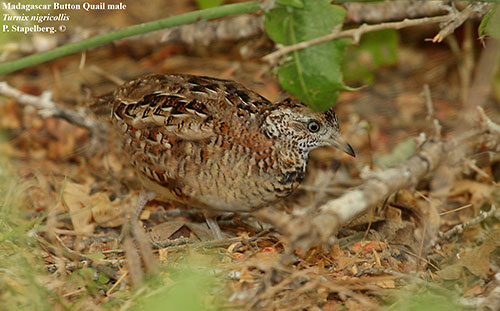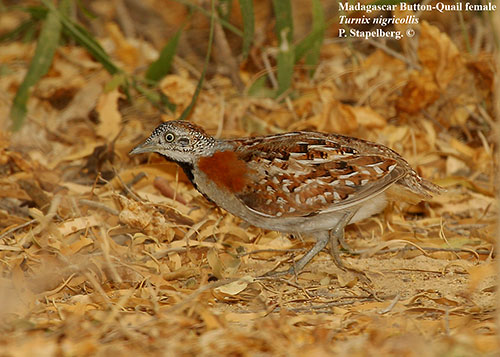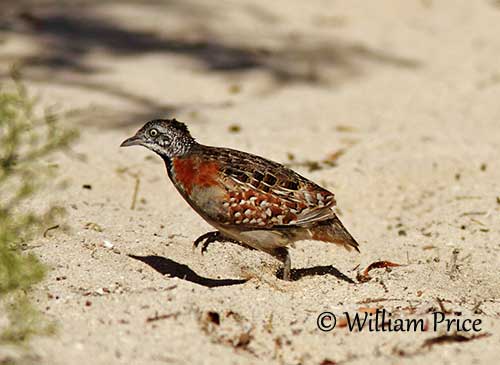
Fr : Turnix de Madagascar
Ang : Madagascar Buttonquail
All : Schwarzkehl-Laufhühnchen
Esp : Torillo Malgache
Ita : Quaglia tridattila del Madagascar
Nd : Madagaskarvechtkwartel
Sd : madagaskarspringhöna
Mal : Kibo, Kibobo
Photographers:
William Price
PBase-tereksandpiper & Flickr William Price
Philip Stapelberg
GALLERY
Alan & Ann Tate
AA Bird Photography
Text by Nicole Bouglouan
Sources:
HANDBOOK OF THE BIRDS OF THE WORLD Vol 3 by Josep del Hoyo-Andrew Elliott-Jordi Sargatal - Lynx Edicions - ISBN : 8487334202
Pheasants, Partridges & Grouse: Including buttonquails, sandgrouse and allies Par Phil McGowan, Steve Madge
Helm Identification Guides – Editeur: Bloomsbury Publishing, 2010 – ISBN: 1408135655, 9781408135655
Wildlife of Madagascar par Ken Behrens,Keith Barnes - ISBN: 140088067X, 9781400880676 – Editeur: Princeton University Press, 2016
Birds of Madagascar and the Indian Ocean Islands Par Roger Safford, Adrian Skerrett, Frank Hawkins – ISBN: 1472924118, 9781472924117- Editeur: Bloomsbury Publishing, 2015
Birds of Madagascar: A Photographic Guide Par Pete Morris, Frank Hawkins – ISBN: 0300077556, 9780300077551- Editeur: Yale University Press, 1998
The Birds of Africa: Volume VIII: The Malagasy Region: Madagascar, Seychelles, Comoros, Mascarenes - Par Roger Safford, Frank Hawkins – ISBN: 1408190494, 9781408190494- Editeur: A&C Black, 2013
Animal Diversity Web (University of Michigan Museum of Zoology)
Wikipedia, the free encyclopaedia
Madagascar Buttonquail
Turnix nigricollis
Charadriiformes Order – Turnicidae Family
INTRODUCTION:
The Madagascar Buttonquail is endemic to Madagascar where it frequents grassy or low brushy habitats woodland and dry spiny and disturbed forests from sea-level up to 1,900 metres of elevation.
It is a small, terrestrial bird that flies only to escape a danger. It feeds on seeds and insects, and is usually seen in pairs or in small groups.
The female has brighter plumage than male and defends the territory while the male incubate the eggs. However, she sometimes takes part in nesting duties and nest-building. She is polyandrous and mates with several males.
The Madagascar Buttonquail is fairly common throughout most of the range, and the species is not currently threatened.

Both sexes have dull bluish-grey bill. The eyes are whitish to greyish-white. Legs and feet are pale greyish to blue-grey. The tarsus is longer than middle toe and its claw.
The juvenile resembles male but the wings have rufous outer webs of secondaries. It appears darker and more heavily streaked.
RANGE:
The Madagascar Buttonquail is endemic to Madagascar, but the species has been introduced on Mauritius, Réunion and Glorieuses Islands. It is now extinct on Mauritius.
HABITAT:
The Madagascar Buttonquail frequents open grassland, steppe, savanna, crops, littoral and spiny forest fringing the humid forest, from sea-level up to 1,900 metres of elevation. However, it is more common in grassy and second growth of closed-canopy gallery forest with thick leaf-litter.
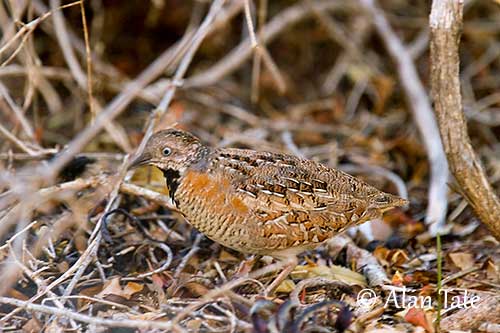
The Madagascar Buttonquail is usually seen in pairs or small groups of 4, sometimes 6-12 individuals. They have diurnal habits.
They roost in circular scrapes on the ground and under the vegetal cover. Several birds of a family group or the mated pair usually roost together, clumping side by side at night or during the hottest hours of the day.
The Madagascar Buttonquail female is polyandrous. She defends the territory and booms frequently to attract a mate. Several displays are performed by Turnix species, but more information is required about the present species.
Both mates search for a nest-site by “scrape-ceremony” during which they scratch a circular scrape, sit in it with cocked tail, and peck the soil or pull grass into the scrape while uttering soft calls. A first “reversed” copulation may occur with the female mounting the male, but a true copulation follows soon. The female finally chooses the nest-site.
The Madagascar Buttonquail is probably sedentary and may be locally dispersive.
This species only flies to escape a danger, although it often runs to reach the cover. When flushed, it has strong, rapid flight and often flies for far with low and direct flight pattern.
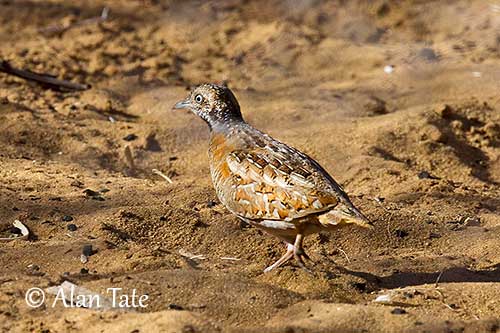
REPRODUCTION OF THIS SPECIES:
The breeding season occurs between August and February in Madagascar, and year-round on Réunion.
The Madagascar Buttonquail breeds in grassy clearings in secondary growth, or in open grassland among brush and tall grasses. It nests solitary.
The nest is a scrape lined with grass, built by both adults. It is placed under clump of grass, or among grass below a small tree or bush. There is often a canopy formed by grasses and a side entrance sometimes with short tunnel.
The female lays 3-5 buff eggs with darker markings. The male incubates alone during 13-16 days. The female may incubate occasionally or she guards the male.
At hatching, the chicks are brown with pale dorsal stripes. They feed themselves at two weeks and are fully feathered and able to fly at three weeks. They are completely independent at one month old.
PROTECTION / THREATS / STATUS:
The Madagascar Buttonquail is fairly common in N, W and SW Madagascar, and less common in E and on High Plateau. It is common on Réunion but extinct on Mauritius, due to introduced predators. It is trapped and hunted for food on Madagascar.
The population is currently stable and the species is not globally threatened.
The Madagascar Buttonquail is currently evaluated as Least Concern.
CALLS AND SONGS: SOUNDS BY XENO-CANTO
The species of genus Turnix have specialized vocal organs allowing the birds to produce loud, low-frequency calls. In this genus, only the females have tracheal enlargement with greater diameter and volume of the organ producing the sounds.
The Madagascar Buttonquail female gives deep, low-pitched booming advertising calls lasting 3-8 seconds. These calls start softly and die away or end abruptly.
We can also hear a short “chut…” repeated for long periods, probably as alarm call.
BEHAVIOUR IN THE WILD:
The Madagascar Buttonquail feeds on a variety of seeds, invertebrates and plant matter. Invertebrates include beetles, flies, cockroaches, true bugs, termites and larvae of Lepidoptera, and gastropods.
It forages by walking on the ground, gleaning and scratching. It hunts by scratching on the ground and pivoting in the deep leaf-litter where it forms a circular or conical feeding scrapes of 9-10 centimetres in diameter.
DESCRIPTION OF THE BIRD:
Biometrics:
Length: 13-16 cm
Weight: M: 60-72 g – F: 59-84 g
The Madagascar Buttonquail is related to waders, but it is more similar to the true quails, although it differs from them in various morphological and behavioural aspects.
The adult male is duller than the female. It has cryptic plumage with pale brown head, streaked and mottled black. Back and wings are greyish-brown with fine dark barring, and the feathers have pale edges, except on outer scapulars where the pattern is more conspicuous. The tail is greyish-brown and finely barred too.
On the underparts, chin and throat are whitish with narrow black bars, becoming broader on the cinnamon-buff breast. Belly and vent are whitish.
The female has brighter-coloured plumage and she is larger than male. She has blackish top of head with fine white markings. Face and upperparts are like in male but the feathers are tipped black. She is brighter overall with more rufous, especially on wing-coverts. We can see a conspicuous whitish moustachial stripe.
On the underparts, the black chin and throat form a dark bib that extends to upper breast, but breast sides are bright rufous. Rest of breast and flanks are grey, the belly is white and the undertail-coverts are rufous.
